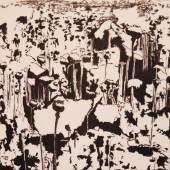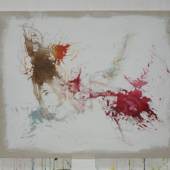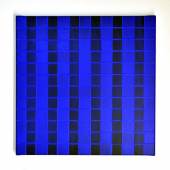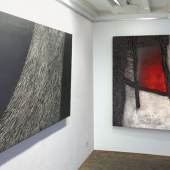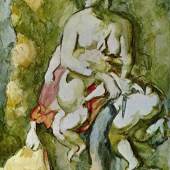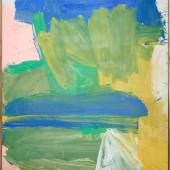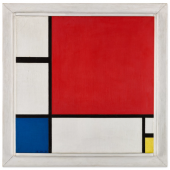Abstract Art Pioneer Piet Mondrian’s Signature Grid Masterpiece, Composition No. II from 1930
-
Auktion14.11.2022
Abstract Art Pioneer Piet Mondrian’s Signature Grid Masterpiece, Composition No. II from 1930, to Star in Sotheby’s Modern Evening Auction this November
Anticipated to Achieve in Excess of $50 Million, the Painting is Among the Most Important & Valuable Works by the Artist Ever Offered at Auction
“There are few artists who have staked such an audacious claim in the history of Modern art as Piet Mondrian, whose grid-style of abstract painting is a truly singular achievement in painting history. Composition No. II is an undeniable masterwork by the artist, bearing the signature hallmarks of Mondrian’s groundbreaking, elemental approach to composition – black lines, forms of primary colors, and geometric precision. The work hums with an electricity that mirrors the energy of painting in Europe at this time and remains as vital as it did when it was painted nearly 100 years ago.”
n his recent review of Hans Janssen’s newly translated biography of the Dutch Modern master Piet Mondrian, The New Yorker art critic Peter Schjeldahl places the artist alongside only Picasso as the premier progenitors of twentieth-century painting: “Pablo Picasso and Piet Mondrian are, to me, the twin groundbreakers of twentieth-century European pictorial art: Picasso the greatest painter who modernized picture-making, and Mondrian the greatest modernizer who painted.” As one of the earliest and most innovative creators of truly abstract painting, Mondrian is not only among the cornerstone figures of Modern art, but also among the great Dutch masters, in company with Rembrandt and Van Gogh, who revolutionized painting and the course of art history in their time.
Possessing the balance and harmony that drove Mondrian to create the most daring compositions of the twentieth century, Composition No. II from 1930 represents the pinnacle of Mondrian’s mature style, which the artist refined during his time in Paris and immersion in the artistic firmament that took hold there during the 1920s and early 1930s. Works from this period are entirely distinct from Mondrian’s earlier movement toward abstraction before and during World War I, as well as from his later period Boogie Woogie works he produced after emigrating to America in 1940.
In Composition No. II, the artist’s signature grid abstraction and geometric composition is on full display; this work is further distinguished by the large red square form occupying the upper right quadrant. Works by Mondrian that have a predominance of the color red are exceptionally rare within his oeuvre, with only 17 paintings of the nearly 120 works executed by the artist from 1921 to 1933 having a focus on the color red, and of this group, only three paintings remain in private hands. Composition No. II comes from a discrete series of square-format canvases, the majority of which are held in museum collections. It is also one of only three of paintings to feature the dominant red square at upper right; the other two works with this feature are both in museum collections (the National Gallery of Belgrade and the Kunsthaus Zurich) and are smaller in size. Composition No. II has an exceptional exhibition and provenance history, and was first exhibited the year it was painted in the inaugural Cercle et Carrée exhibition in Paris.
Reflecting on his artistic evolution, his aims as an artist, and how a primary color such as red would come to feature so prominently in his work, Mondrian recounted how his “work unconsciously began to deviate more and more from the natural aspects of reality...The first thing to change in my painting was the color. I forsook natural color for pure color.”
Coming to auction for the first time in nearly 40 years on 14 November at Sotheby’s Modern Evening Auction, Composition No. II is anticipated to sell for in excess of $50 million, making this work one of the most significant and valuable works by the artist ever offered on the market. When the painting was sold at auction in 1983, it achieved the highest price ever paid at the time for a work by Mondrian and for a work of abstract art at auction, as reported in The New York Times.
“Quintessential works by Piet Mondrian rarely come to auction as many are housed in the most prestigious museum collections around the world. Composition No. II embodies everything you could want from a Mondrian – it is a seminal painting that is both crucial to the development of Modern art and emblematic of the enduring appeal of the Modern aesthetic, characterized by a serene sense of compositional balance and spatial order, and with superb provenance. On his path towards abstraction, Mondrian reached an epiphany with the works he created at the peak of his career. The opportunity to acquire a painting of this quality is truly a once-in-a- generation occurrence.”
Julian Dawes, Sotheby’s Head of Impressionist & Modern Art, Americas
-
12.04.2021 - 14.04.2021By Pak • 12- 14 April • A novel collection of digital art redefining our understanding...
-
20.04.2022ARTEXPO NEW YORK CELEBRATES ITS 45TH ANNUAL EDITION WITH A RENAISSANCE IN CONTEMPORARY AND FINE...
-
04.05.2018 - 08.05.2018(New York) April 25, 2018 – TEFAF, the not-for-profit foundation that organizes three art...
-
Wo Sie die Werke Cézannes besichtigen können: Kunsthaus, Zürich „Das...
-
16.04.2024 - 15.09.2024Two stays in Italy inspired Willem de Kooning to bold experiments in his art, a new exhibition in...
-
20.04.2024 - 24.11.2024Jeffrey Gibson on Representing the United States and Himself By Melissa Smith | Feb 16, 2024 From...
-
14.11.2022Auktion »
.

